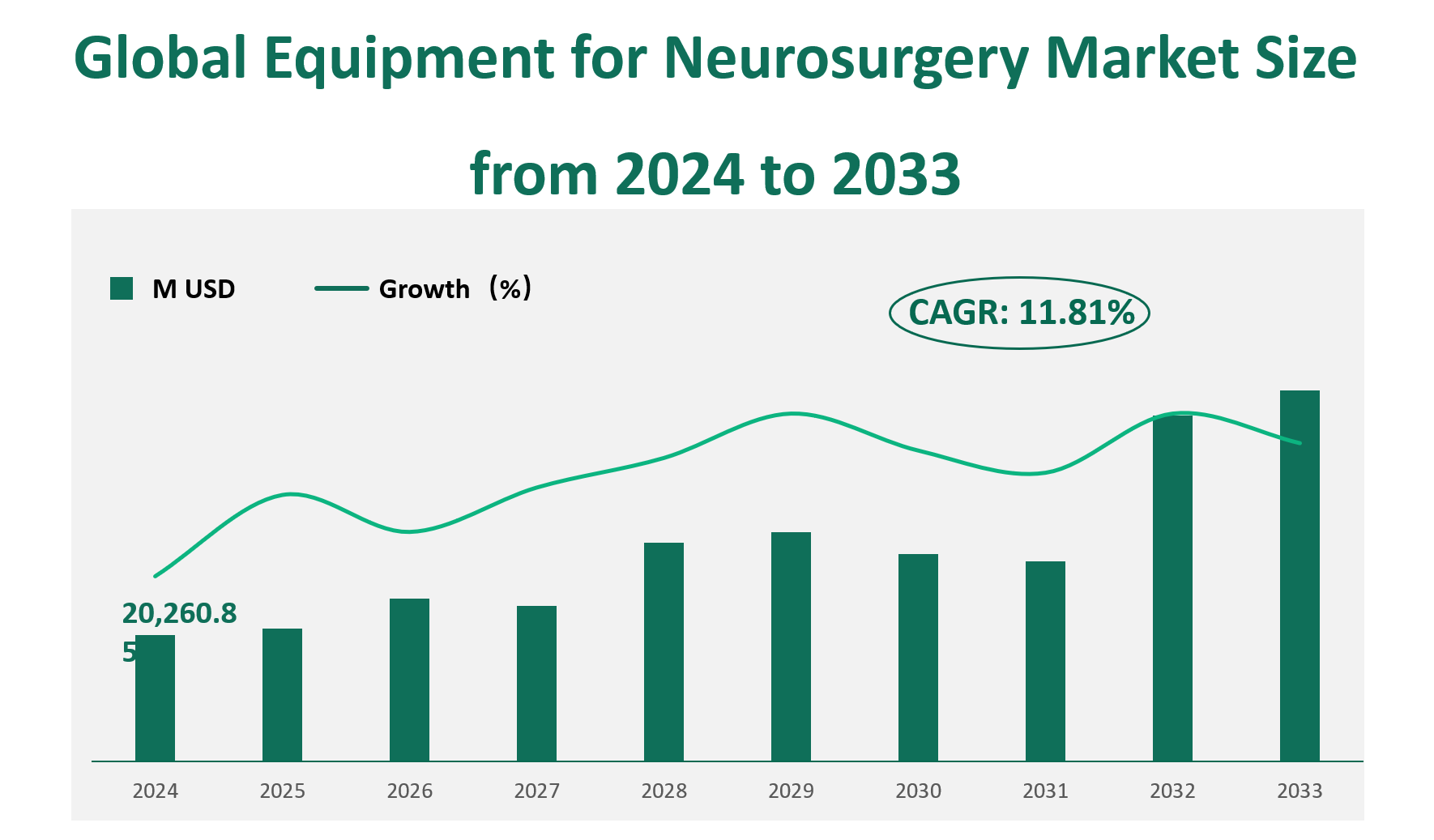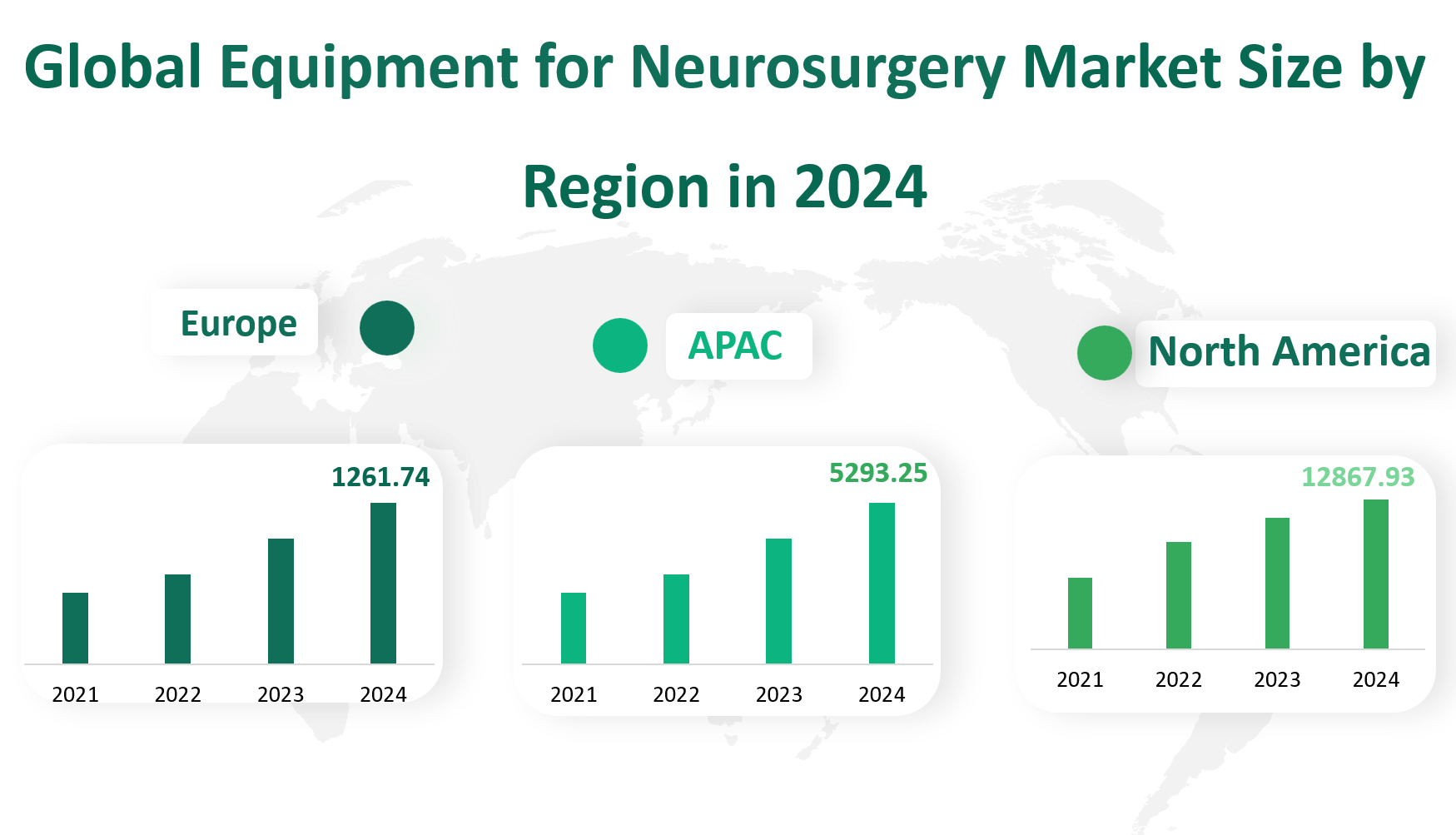1. Global Equipment for Neurosurgery Market Insight Analysis
The global Equipment for Neurosurgery market is projected to reach a revenue of 20,260.85 million USD in 2024, with a Compound Annual Growth Rate (CAGR) of approximately 11.81% from 2024 to 2033.
Equipment for Neurosurgery refers to a range of specialized medical devices and instruments used in the diagnosis, treatment, and management of neurological conditions. These include neuroendoscopes, neurosurgery microscopes, neurointerventional devices, gamma knives, and digital subtraction angiography equipment.
These tools are essential for performing minimally invasive surgeries, improving surgical precision, and enhancing patient outcomes. The market for such equipment is highly specialized, with stringent regulatory requirements to ensure safety and efficacy. The integration of advanced technologies such as artificial intelligence, robotics, and high-definition imaging has further enhanced the capabilities of these devices, making them indispensable in modern neurosurgical practices.
Figure Global Equipment for Neurosurgery Market Size (M USD) and CAGR (2024-2033)

2. Driving and Limiting Factors of Equipment for Neurosurgery Market Growth
The growth of the Equipment for Neurosurgery market is driven by several key factors. Firstly, the increasing prevalence of neurological disorders, such as brain tumors, cerebrovascular diseases, and neurodegenerative conditions, has led to a higher demand for advanced surgical equipment. As populations age and healthcare awareness increases, the incidence of these conditions is expected to rise, further driving market growth.
Secondly, technological advancements in neurosurgical equipment have significantly improved surgical outcomes, making these tools more attractive to healthcare providers. The integration of artificial intelligence and robotic assistance has enhanced the precision and safety of neurosurgical procedures, reducing the risk of complications and improving patient recovery times.
One of the primary challenges is the stringent regulatory environment, particularly in regions such as North America and Europe. The approval process for new neurosurgical devices is rigorous and time-consuming, which can delay the introduction of innovative products to the market. Additionally, the high cost of advanced neurosurgical equipment can be a barrier for some healthcare providers, particularly in developing countries. The complexity of these devices also requires specialized training for healthcare professionals, which can limit their widespread adoption.
3. Technology Innovation and Corporate Mergers and Acquisitions in Equipment for Neurosurgery Market
The Equipment for Neurosurgery market is characterized by continuous technological innovation. Companies are investing heavily in research and development to introduce new and improved devices that enhance surgical precision, reduce invasiveness, and improve patient outcomes. For instance, the development of neuroendoscopes with high-definition imaging capabilities and advanced neurosurgery microscopes with enhanced visualization features are transforming the way neurosurgical procedures are performed. The integration of artificial intelligence and machine learning algorithms into neurosurgical equipment is also a growing trend, enabling real-time data analysis and improved decision-making during surgeries.
Corporate mergers and acquisitions have played a significant role in shaping the market landscape. Major players in the industry, such as Canon Medical Systems Corporation, Siemens Healthineers, GE Healthcare, Philips Healthcare, and Elekta, have been actively involved in strategic partnerships and acquisitions to expand their product portfolios and strengthen their market positions. These activities have led to the consolidation of the market, with a few large players dominating the industry. For example, Siemens Healthineers’ acquisition of certain assets from Varian Medical Systems has enhanced its capabilities in radiation therapy and oncology solutions. Similarly, GE Healthcare’s strategic partnerships have allowed it to leverage advanced technologies and expand its global reach.
4. Global Equipment for Neurosurgery Market Size by Type
The Equipment for Neurosurgery market is segmented into several key product types, each with its own unique characteristics and market dynamics. These product types include Neuroendoscopes, Neurosurgery Microscopes, Neurointerventional Devices, Gamma Knife, Digital Subtraction Angiography (DSA), and Others.
Neuroendoscopes are specialized medical devices used to visualize and treat conditions within the brain and spinal cord. They are equipped with high-resolution cameras and advanced imaging technologies, allowing surgeons to perform minimally invasive procedures. In 2024, the market revenue for Neuroendoscopes is forecasted to reach approximately 155.54 million USD. This product type is particularly important for surgeries involving hydrocephalus, tumor removal, and other intracranial procedures.
Neurosurgery microscopes are essential tools for neurosurgeons, providing high-resolution, magnified views of the surgical site. These microscopes often come with advanced features such as fluorescence imaging and 3D visualization, which enhance surgical precision and outcomes. The market revenue for Neurosurgery Microscopes in 2024 is projected to be around 4,888.94 million USD. Their versatility and critical role in complex neurosurgical procedures make them a significant part of the market.
Neurointerventional devices encompass a range of tools used for minimally invasive procedures, including catheters, guidewires, and stents. These devices are crucial for treating conditions such as aneurysms, arteriovenous malformations, and ischemic strokes. The market revenue for Neurointerventional Devices in 2024 is expected to be approximately 5,664.54 million USD.
The Gamma Knife is a non-invasive treatment for brain disorders, using focused gamma radiation to target and treat tumors, vascular malformations, and other conditions. It is known for its precision and ability to deliver high doses of radiation to small, well-defined targets. The market revenue for Gamma Knife in 2024 is forecasted to be around 706.13 million USD.
Digital Subtraction Angiography is a specialized imaging technique used to visualize blood vessels in the brain and spinal cord. It involves the injection of a contrast agent and the use of X-rays to create detailed images of blood flow. The market revenue for DSA in 2024 is projected to be approximately 8,592.80 million USD.
Table Global Equipment for Neurosurgery Market Size by Type in 2024
Market Size (M USD) 2024 | Market Share | |
Neuroendoscope | 155.54 | 0.77% |
Neurosurgery Microscopes | 4888.94 | 24.13% |
Neurointerventional Devices | 5664.54 | 27.96% |
Gamma Knife | 706.13 | 3.49% |
Digital subtraction angiography | 8592.80 | 42.41% |
Others | 252.91 | 1.25% |
5. Global Equipment for Neurosurgery Market Size by Application
The Equipment for Neurosurgery market is also segmented based on its applications, which include Preoperative, Intraoperative Use, Intraoperative Consumption, and Others.
Preoperative equipment for neurosurgery includes tools and technologies used in the planning and preparation stages of neurosurgical procedures. This can involve imaging studies, diagnostic tests, and surgical planning software. The market revenue for Preoperative equipment in 2024 is forecasted to be approximately 8,029.97 million USD.
Intraoperative use equipment refers to tools and technologies used during the surgical procedure itself. This includes surgical instruments, imaging devices, and monitoring equipment. The market revenue for Intraoperative Use equipment in 2024 is projected to be around 9,425.98 million USD.
Intraoperative consumption equipment includes disposable items and consumables used during surgery, such as surgical drapes, sutures, and other single-use items. The market revenue for Intraoperative Consumption equipment in 2024 is expected to be approximately 2,058.69 million USD.
Table Global Equipment for Neurosurgery Market Size by Application in 2024
| Market Size (M USD) 2024 | Market Share |
Preoperative | 8029.97 | 39.63% |
Intraoperative Use | 9425.98 | 46.52% |
Intraoperative Consumption | 2058.69 | 10.16% |
Other | 746.21 | 3.68% |
6. Global Equipment for Neurosurgery Market by Top Regions
North America is a significant market for neurosurgery equipment, driven by advanced healthcare infrastructure, high demand for precision medical devices, and robust research and development activities. In 2024, the market revenue for neurosurgery equipment in North America is forecasted to reach approximately 12,867.93 million USD.
Europe is another major market for neurosurgery equipment, characterized by a high demand for advanced medical technologies and a well-established healthcare system. The market revenue for neurosurgery equipment in Europe in 2024 is projected to be around 12,617.44 million USD.
The Asia-Pacific region is emerging as a significant market for neurosurgery equipment, driven by rapid economic growth, increasing healthcare expenditure, and a growing aging population. In 2024, the market revenue for neurosurgery equipment in the Asia-Pacific region is forecasted to reach approximately 5,293.25 million USD.
South America is a developing market for neurosurgery equipment, driven by increasing healthcare needs and improving healthcare infrastructure. In 2024, the market revenue for neurosurgery equipment in South America is projected to be around 518.93 million USD.
The Middle East and Africa region is also a developing market for neurosurgery equipment, driven by increasing healthcare expenditure and a growing demand for advanced medical technologies. In 2024, the market revenue for neurosurgery equipment in this region is forecasted to reach approximately 319.00 million USD.
Figure Global Equipment for Neurosurgery Market Size by Region in 2024

7. Global Equipment for Neurosurgery Market Analysis by Major Players
7.1 Canon Medical Systems Corporation
Company Introduction and Business Overview: Canon Medical Systems Corporation is a leading provider of diagnostic medical imaging solutions, including CT, MR, X-Ray, Ultrasound, and Healthcare Informatics. Established in 1948, the company has a global presence with manufacturing facilities in Asia, Europe, and Brazil.
Products Offered: Canon Medical offers a range of neurosurgery equipment, including the Alphenix system for interventional neurology. This system provides high-definition imaging and advanced visualization tools, enhancing surgical precision and outcomes.
7.2 Siemens Healthineers
Company Introduction and Business Overview: Siemens Healthineers is a global medical technology company, providing a wide range of healthcare solutions, including medical imaging, laboratory diagnostics, and digital health services. Established in 1896, the company has a strong presence in the United States, Europe, and China.
Products Offered: Siemens Healthineers offers advanced neurosurgery equipment, such as the CT Neuro Engine, which helps reduce door-to-needle time in stroke treatment. This system provides high-precision imaging and advanced diagnostic capabilities.
7.3 GE Healthcare
Company Introduction and Business Overview: GE Healthcare is a leading global medical technology and digital solutions innovator, providing intelligent devices, data analytics, applications, and services. Established in 1994, the company has a global presence with manufacturing facilities worldwide.
Products Offered: GE Healthcare offers a range of neurosurgery equipment, including the OEC Elite CFD, which provides stunning image clarity and detail at low dose. This system enhances surgical precision and patient safety.

